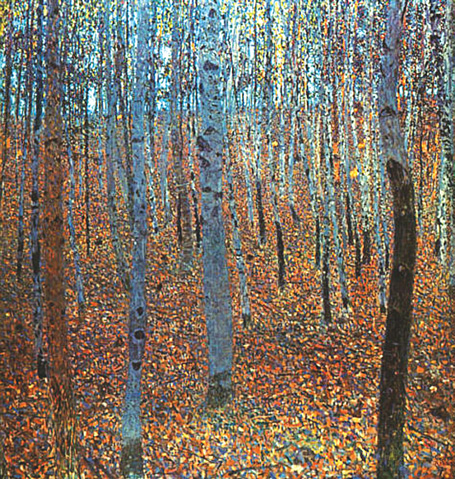
NATALIE SENIOR GREENBERG
A new and exciting cultural destination will open this fall in New York! called Hall de Lumières, it will be the city’s first permanent venue to experience immersive digital art and showcase a new, innovative way for audiences to interact with artists and their work. It will present new, exhibitions every ten to twelve months based on the work of different world-renowned artists, beginning with their first exhibition—Gustav Klimt: Gold in Motion.
This exhibit will feature glowing, animated images of historic artworks by this early modernist master, blended with music and displayed against the landmark interior architecture of the former Emigrant Industrial Savings Bank located at 49 Chambers Street, across from City Hall. If you have seen and enjoyed Van Gogh: The Immersive Experience, then you will love Gustav Klimt: Gold in Motion.
Gustav Klimt painted at the beginning of the 20th century and was influenced by the then current styles of Art Nouveau or Jugendstil. These styles were originally applied to the decorative arts but then extended to the fine arts. They were organic motifs with the curlicues, asymmetry, and swirling lines of nature.

He is most famous for his Gold Period of paintings, where he used actual gold and silver leaf for a gleaming effect in his work. The son of a gilder, Klimt integrated the fine layers of gold and silver leaf into his work to merge the figures with the background and convey an impression of otherworldly treasure. His use of gold gives his works a timeless quality; the absence of perspective and shadow make them look like religious icons reminiscent of medieval paintings and illuminated manuscripts. Klimt’s Gold Period produced many beloved masterpieces including The Kiss, Judith, and Adele Bloch Bauer.
In one of Klimt’s most famous works, The Kiss, he depicts a couple locked in an embrace. All that is visible of the couple are parts of their heads. The rest of the painting dissolves into a shimmering, flat patterning of gold and geometric shapes. He uses rounds and ovals on the woman’s clothing and mostly rectangular shapes on the man’s garment. The entire work glows and visually expresses the emotional and physical explosion of love.
At Gustav Klimt: Gold in Motion, visitors will experience six distinct sequences carrying them through the artist’s life and the major themes of his work. Visitors will be able to learn about his early days as a painter in the late 19th century, decorating the lavish public buildings of Vienna. In the early 20th century, Klimt began to express himself in a more personal style. He became a leader of the Vienna Secession, a movement that broke from the traditional styles of the past and moved toward a more modern view.
The installation features luminescent, 30-foot-high images of famous works by Klimt, moving across the spectacular architecture and aligned precisely to the specifications of the building. A musical soundtrack created specifically for this presentation completes this beautiful, sensory experience.
Visitors to the Hall de Lumières will also be able to learn about the history and design of the Emigrant Savings Bank, which was built around the same time as Klimt was creating his masterpieces. It was one of the first skyscrapers built in the Beaux-Arts style. Also on view will be panels displaying images of Klimt’s paintings shown at actual scale, with information about the museums across the globe where these works can be seen.


In addition to his works, the show will feature other early 20th century Austrian artists who were influenced by Klimt, including Egon Schiele and Friedensreich Hundertwasser.
If after seeing this exhibit you would like to see actual paintings by Gustav Klimt, here are some other New York museums that feature his work: The Neue Gallerie (86th Street and Fifth Avenue) houses Klimt’s Adele Bloch Bauer, a painting so dazzling, that it is difficult not to be totally entranced by it. This painting has an interesting back-story. In 1938, the Nazi’s stole it from the Jewish Bloch-Bauer family. The descendants of its original owners recently recovered it from the Austrian government after a prolonged court battle. It was then sold to Ronald Lauder, who is now displaying it as the centerpiece of his Neue Gallerie Museum.

The Museum of Modern Art (West 54th Street, between 5th and 6th Avenues) exhibits Klimt’s Hope, a painting of a pregnant woman who is praying for the safety of her baby. This work, with its swirling shapes and exuberant colors, embodies the feelings associated with the miracle of childbirth. It is the gift of this painter to be able to draw the viewer into his paintings and impart such emotion.
On view at the Metropolitan Museum of Art (82nd Street and Fifth Avenue) are two noteworthy paintings by Klimt; Mada Primavesi, a portrait of a 9 year old girl. It was commissioned by her parents, who were supporters of progressive Viennese art. An earlier portrait by Klimt, of Serena Pulitzer Lederer, was painted with soft sinuous brushstrokes in all white. Lederer’s husband commissioned this portrait of his wife and became one of Klimt’s most important patrons in the years to come. Other works commissioned by Klimt for the Lederer family were seized as Jewish property by the Nazi’s in the early 1940s and then stored at Schloss Immendorf, a castle in Austria. The German troops set it on fire as the Russians approached in 1945, in the last days of WWII. It is so sad that the world has lost these important paintings.
Hall de Lumieres opened on September 14, 2022. Hours: Sunday through Wednesday, 10 A.M. to 7 P.M. Thursday through Saturday, 10 A.M. to 10 P.M. It is located at 49 Chambers Street New York.

Natalie Senior Greenberg is a Brooklyn College Art History professor, and the founder, curator and owner of an online art gallery.



